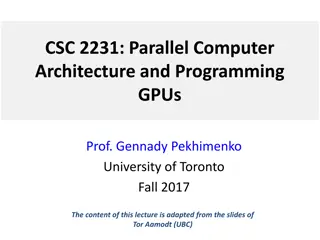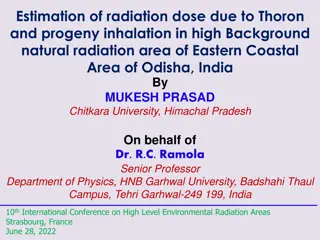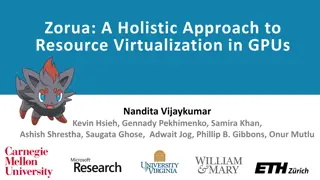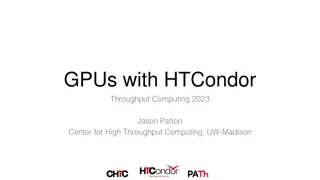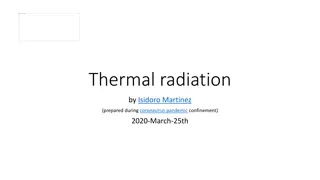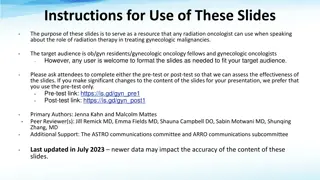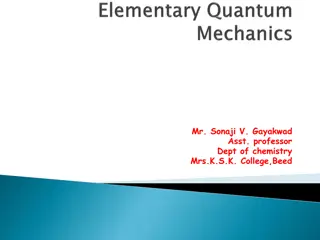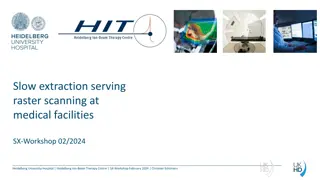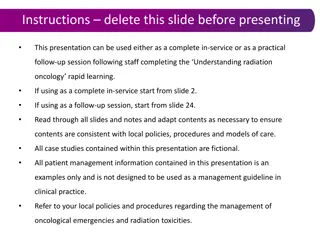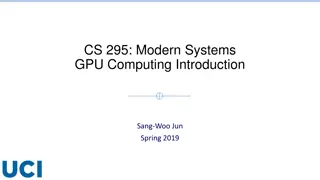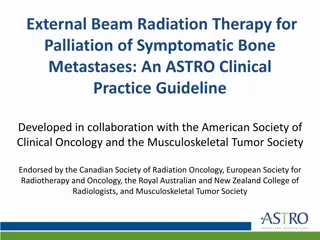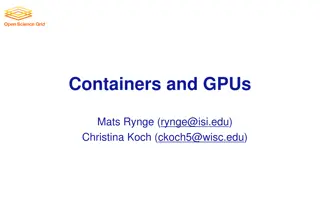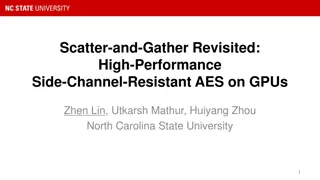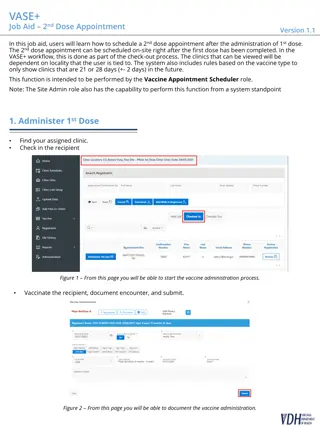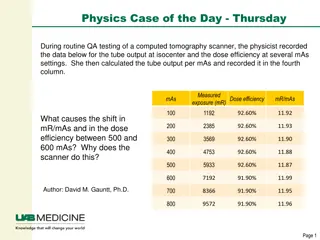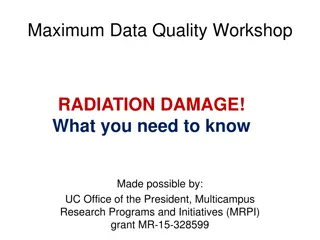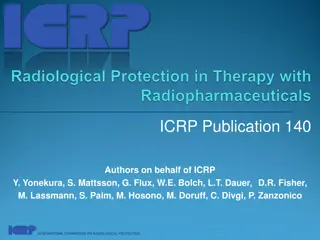Accelerating Radiation Therapy Dose Calculations with Nvidia GPUs
Accelerating Radiation Therapy Dose Calculations with Nvidia GPUs by Felix Liu, Niclas Jansson, Artur Podobas, Albin Fredriksson, and Stefano Markidis discusses the utilization of GPU technology to improve efficiency in radiation treatment planning. The process involves creating patient-specific treatment plans by solving mathematical optimization problems iteratively. By porting proton dose calculations to GPUs with mixed half/double precision, the study aims to enhance performance compared to traditional CPU implementations, leading to higher productivity and quality treatment plans.
Download Presentation

Please find below an Image/Link to download the presentation.
The content on the website is provided AS IS for your information and personal use only. It may not be sold, licensed, or shared on other websites without obtaining consent from the author. Download presentation by click this link. If you encounter any issues during the download, it is possible that the publisher has removed the file from their server.
E N D
Presentation Transcript
Accelerating Radiation Therapy Dose Calculations with Nvidia GPUs Felix Liu1,2, Niclas Jansson1, Artur Podobas1,Albin Fredriksson2, Stefano Markidis1 1. 2. KTH Royal Institute of Technology RaySearch Laboratories
Background - Motivation Radiation Treatment Planning (RTP) is the process of creating individual, patient- specific, treatment plans for radiation therapy Time consuming process Computationally intensive Iterative trial-and-error when creating treatment plan More efficient treatment planning Higher productivity at clinics Enables more sophisticated optimization methods (Robustness, multi-criteria optimization, online adaptive etc.) Higher quality treatment plans 2024-09-18 2
Background What is RTP? Treatment machine needs control parameters to deliver treatment These control parameters are the treatment plan Determined by formulating a mathematical optimization problem Promote sufficient dose to tumour, and low dose to surrounding organs Optimization problem solved iteratively Need dose computations at each iteration For some cases a majority of the optimization time is spent on dose computations 2024-09-18 3
Proton Therapy Dose Calculation Dose is delivered through pencil beam scanning Machine parameters are spot weights, the intensity of the beam at each spot Dose deposition matrix is calculated using e.g. Monte Carlo methods Computing the dose becomes a matrix multiplication ?? = ? ? is the dose deposition matrix, ? are the spot weights ? is the (flattened) dose per voxel Dose deposition matrices typically highly sparse 2024-09-18 4
Dose Deposition Matrices Matrices from two cases used: one liver and one prostate case Liver case consists of 4 beams with one dose deposition matrix for each beam. Prostate case has 2 beams Dose deposition matrices exported from RayStation RaySearch s treatment planning system Large number of rows with no non- zeros, ~70% 2024-09-18 5
This Work Port the performance critical proton dose calculation to GPU using CSR Mixed half/double precision, half precision for matrix entries and double precision for input output. Similar to RayStation s current implementation Double precision for optimization algorithm, half precision to save space. Comparison with current RayStation CPU implementation and RayStation s CPU algorithm ported to GPU Comparison also with state-of-the-art library implementations, in single precision (Half / double mixed precision unsupported) Ginkgo1 cuSPARSE 1. https://ginkgo-project.github.io/ginkgo/doc/develop/index.html 2024-09-18 6
Sparse Matrices - CSR Format Store matrix using 3 arrays Non-zero elements -> Data Column indices of each non-zero element -> Col idxs Where, in the other 2 arrays, each row starts -> Row Pointers Row based orderings suited for SpMV Parallelize over matrix rows Accumulate local value 2024-09-18 7
CSR SpMV Kernel Largely follows the implementation described in [1]. Warp coordination using CUDA cooperative groups Each row processed by one thread warp Skip empty rows (up to ~70% of rows empty in our case) Calculate dot product Warp-wide reduction using Coop. groups API [1] Bell, Nathan, and Michael Garland. "Implementing Sparse Matrix-Vector Multiplication on Throughput-oriented Processors." Proceedings of the Conference on High Performance Computing Networking, Storage and Analysis. 2009. 2024-09-18 8
Terminology We will refer to our kernels by their floating point precision schemes. Half/double will refer to our kernel in mixed half and double precision, single to our kernel in single precision only. Our port of the RayStation algorithm to GPU is called GPU baseline. State-of-the-art library implementations referred to by their names. 2024-09-18 9
Experiments Measurements done on Nvidia A100, V100 and P100 GPUs, and CPU measurements done on Intel i9 7940X Half/double, Single, GPU baseline and RayStation s CPU algorithm on the A100 and i9 CPU Single with Ginkgo and cuSPARSE on the A100 Half/double on the A100, V100 and P100 Roofline analysis on the A100, using metrics collected by Nvidia Nsight 2024-09-18 10
A100 performance 2024-09-18 11
A100 Library comparison 2024-09-18 12
Comparison Between GPUs For the liver cases, we achieve roughly 80-87% of the peak theoretical bandwidth on the A100 and V100. The achieved bandwidth for the P100 is around 41% of peak, significantly lower. 2024-09-18 13
Roofline Half/double has higher operational intensity, which expains the difference in performance Single precision versions have lower operational intensity, hence lower performance Half/double performance ~80% of roofline for liver and ~68% for prostate 2024-09-18 14
Operational Intensity Memory traffic mainly from reading matrix elements and input vector elements. Number of columns quite small means input vector fits in cache. Reading from the input vector does not contribute a lot to memory traffic from main memory. Non-zero elements dominate memory traffic to main memory! 2024-09-18 15
Memory Traffic Model Assume infinite cache size Data only read from main memory once Let: ?? = ?????? ?? ???? ?? = ?????? ?? ?????? ??? = ?????? ?? ??? ????? Total main memory traffic in bytes (simplified) 6 ??? + 12 ?? + 8 ?? 2 ??? FLOPs Plugging in values we get an op. intensity of 0.335 (measured value 0.33) ??? dominates other terms Matrix elements & column indexes 2024-09-18 16
Conclusions GPU acceleration of the proton dose summation could provide significant performance benefits, and reduce time required for treatment planning CSR implementation achieves ~50 speedup on A100 compared to RayStation s CPU implementation. For dose deposition matrices, a simple GPU implementation can achieve performance comparable to state-of-the-art libraries Further improvements can be made in storing the column indexes. 2024-09-18 17
Thank you for listening! 2024-09-18 18


